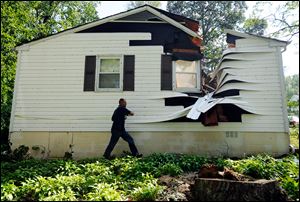
Flood damage? Few Irene victims covered unless they had flood insurance
8/29/2011
Darrell Tarte, a property estimator with Erie Insurance, surveys damage from a tree at a home in Port Republic, Md. after Hurricane Irene Sunday, Aug. 28, 2011. Hurricane Irene left nearly a million people without power in the Mid-Atlantic region Sunday, filling low-lying roads with water and bringing trees down on power lines, streets and rail tracks.
Hurricane Irene is providing a painful reminder that the vast majority of homeowners insurance policies do not cover damage from flooding.
That's a difficult reality for those who spent Monday cleaning up flooded basements, cursing a failed sump pump, or fixing other water damage.
Whether water damage is covered depends on how it came about. Standard homeowners policies cover structural and water damage when wind or a falling tree knocks a hole in a roof, or breaks a window, allowing rain to fall inside. But there's generally no coverage for the home itself, or for personal belongings, when damage results from rising water. That includes water that seeps up from saturated ground through a basement floor, and homes near beaches flooded by storm surges.
When Irene hit the East Coast over the weekend, flood damage was greater than wind damage in most regions. Inland areas were among those hardest hit by rains that produced flash floods.
Yet many homeowners will be stuck paying all repair costs out-of-pocket, after claims adjusters conclude upon inspection that flooding was to blame, and therefore damages aren't covered.
That experience could cause many to reconsider whether to buy a separate flood insurance policy in time for the next storm.
"Nothing sells flood insurance like a flood," said Robert Hartwig, president of the industry's Insurance Information Institute. "It's always the case that we see a surge in flood insurance sales in the wake of a flood."
A poll this year by the Institute found that just 14 percent of homeowners had a flood insurance policy. The lowest coverage was in a region hit by Irene: the Northeast, with 5 percent. The highest coverage rate was in the South, with 19 percent.
Coverage remains low despite court cases consistently upholding the industry's denial of homeowners insurance claims involving damage from flooding, rather than wind, Hartwig said. A series of lawsuits followed in the wake of Hurricane Katrina, which hit the Gulf Coast in 2005.
Nearly all flood coverage is purchased through the government's National Insurance Program. Homeowners, renters and business owners in about 21,000 communities nationwide are eligible to purchase federally backed flood policies, typically through private insurers that market the coverage. A list of participating insurers is at www.fema.gov/nfipinsurance/search.do .
The average flood policy costs around $600 a year, but can start around $129 in low-risk areas, according to the Federal Emergency Management Agency, which administers the insurance program. The average paid claim over the last five years was nearly $34,000.
In Vermont, just 3,673 flood insurance policies were in effect at the end of June, according to federal data. Yet the landlocked state was one of the hardest hit by Irene's flooding.
Property owners who aren't in high-risk areas file more than 20 percent of claims with the national flood program, and receive one-third of disaster assistance for flooding, according to FEMA.
For those recovering from Irene, here's additional information about coverage from hurricane-related damages:
— Hurricane deductibles: Out-of-pocket expenses for damages from hurricanes can be much higher than from other types of disasters. Standard homeowners policies include deductibles of either $500 or $1,000, meaning the homeowner must pay that amount before insurance covers the rest of the damages.
But in 18 states on the East and Gulf coasts, insurers are allowed to include hurricane deductibles in homeowners policies. These amounts apply only to hurricane-caused damage, and typically range from 1 percent to 5 percent of the insured value of a home. Deductibles may be higher in some coastal areas, and vary among insurers. For example, a policyholder whose home is insured for $200,000 with a 2 percent hurricane deductible would have to pay the first $4,000 to repair hurricane damage. The hurricane-prone states that allow insurers to assess hurricane deductibles include: Alabama, Connecticut, Delaware, Florida, Georgia, Hawaii, Louisiana, Maine, Maryland, Massachusetts, Mississippi, New Jersey, New York, North Carolina, Rhode Island, South Carolina, Texas and Virginia. The District of Columbia is included.
— Renters insurance: Policies for renters cover belongings damaged by storm winds. For flood coverage, most policies require that separate coverage be purchased through the National Flood Insurance Program. Structural damage to an apartment building is covered under the building owner's policy.
— Property other than the main house: Standard homeowners policies cover wind damage to attached garages or decks, as well as unattached structures, such as a separate garage, or a shed or swimming pool. Contents of those structures also are covered.
— Fallen trees: Homeowners policies do not pay to remove trees that fall without damaging the house, or another structure on the property. There is coverage if the house or structure is damaged. If a tree on your property falls on a neighbor's home, the neighbor's coverage generally will cover damages.
— Cars: If your automobile is damaged by flood waters from a hurricane or other disaster, expect coverage if you've purchased comprehensive auto insurance, which covers damages from causes other than collisions. About 80 percent of U.S. drivers have comprehensive coverage. If you've only got liability coverage, flood damage to a car won't be covered.
— Spoiled food: Many homeowners have been left with spoiled food after Irene knocked out electricity to refrigerators and freezers. After hurricanes, most insurers cover food spoilage. You're generally entitled to $250 to $500 per refrigerator or freezer.